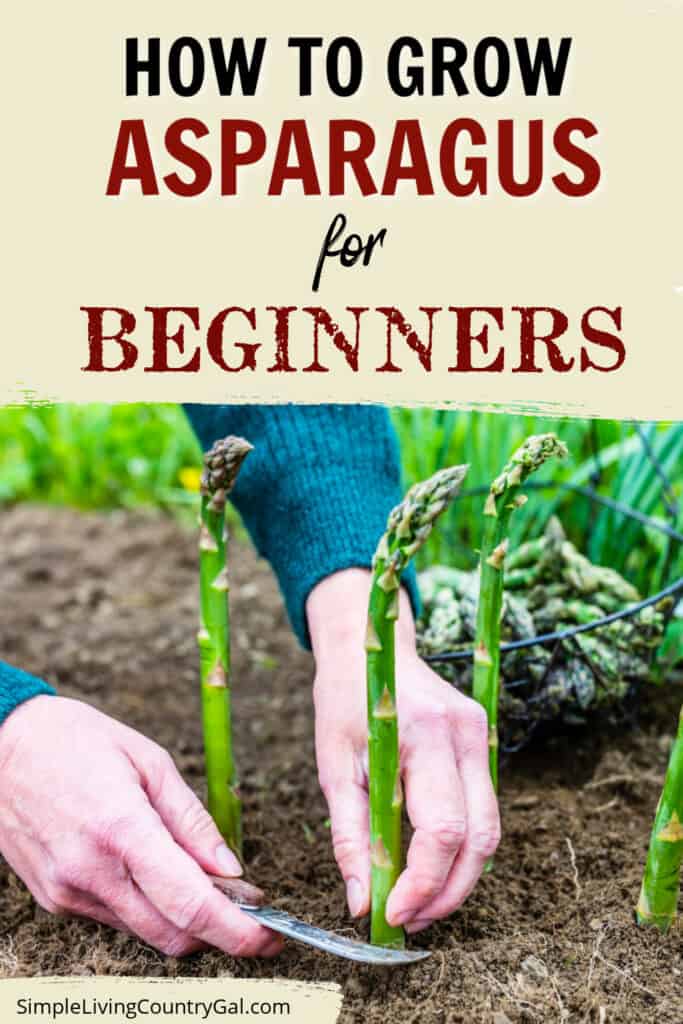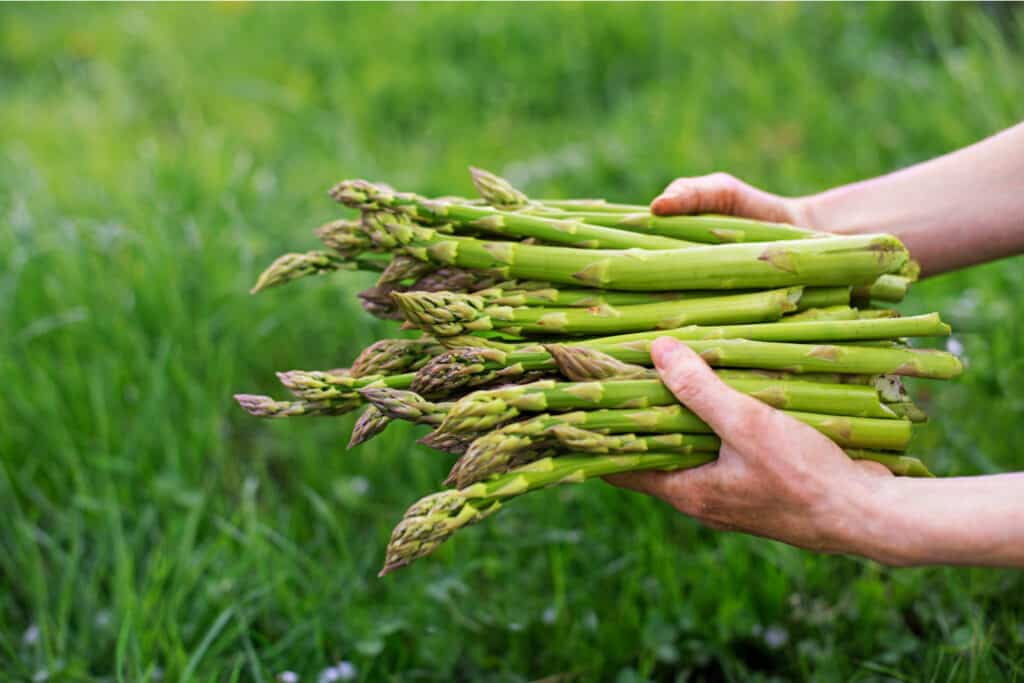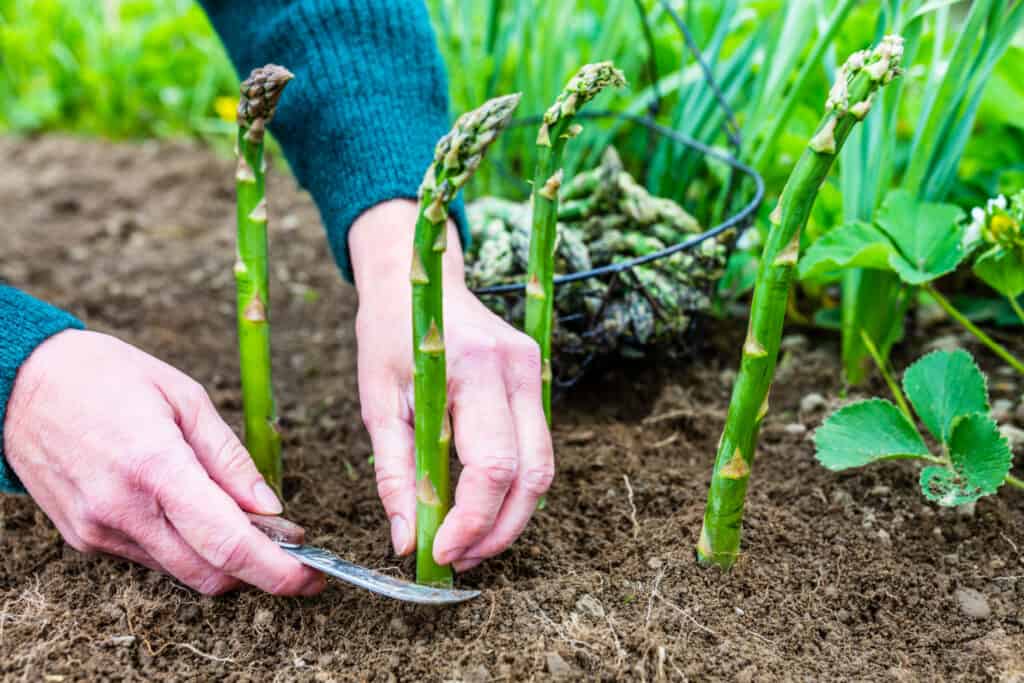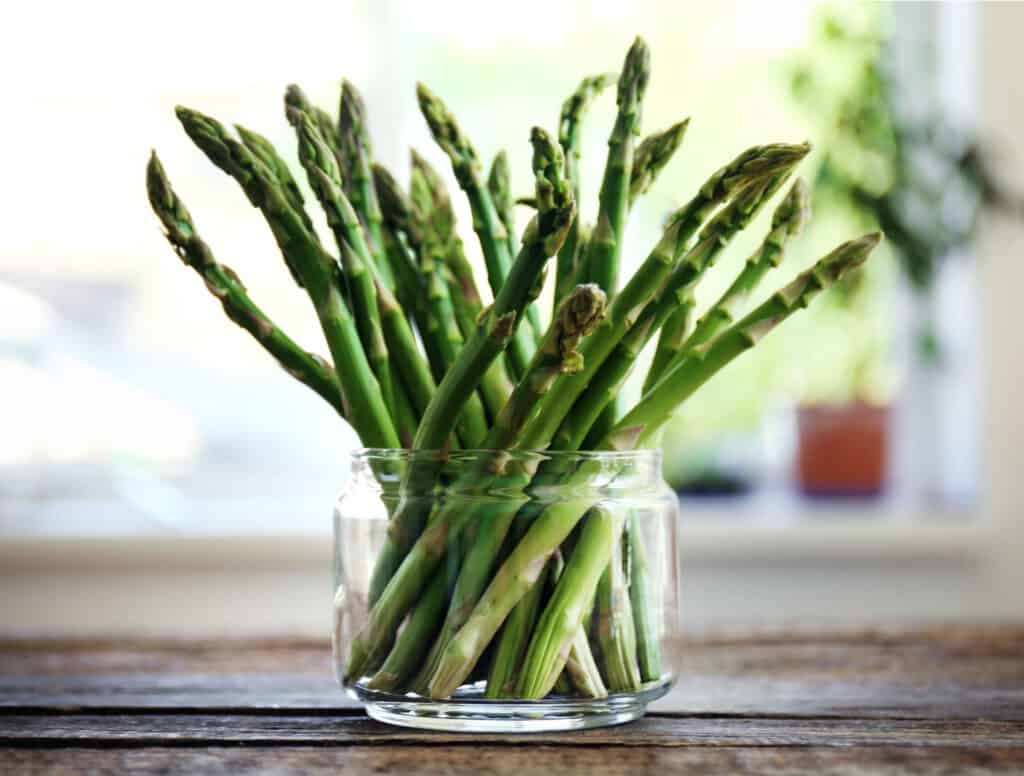How to Grow Asparagus for Beginners
If you have always wanted to add this amazing vegetable to your backyard garden, then learning How to Grow Asparagus for Beginners is the guide that will help. Know where and how to plant and see what you can do to keep things growing strong and healthy year after year.
Another easy guide for your gardening 101 library that will walk you through from seedling all the way to harvest.

Asparagus is an easy vegetable to grow for beginners. It doesn’t take a lot of experience, and it’s basically foolproof. But it does take some time and requires a bit of patience. Asparagus plants need a bit of growing time as they cannot be harvested for at least 3 years. The good news is they will continue to produce for up to 20 years so you can expect to enjoy it for a long time to come.
If you want to try a shortcut, you can reduce the harvest time by planting crowns instead of seeds. This will shorten the growing time just a bit while still giving many years of harvest.

There are several varieties of asparagus that you can choose for your garden:
- Jersey Knight – male plants that produce a large harvest
- Jersey Giant – male plants that grow well in the East and Midwest
- Mary Washington – female plants that are a traditional heirloom variety
- Millennium F1 – male plants that grow well in very cold temperatures, perfect in northern gardens
- Larac – both male and female plants that are pale, almost white
- Purple Passion – both male and female, they’re colorful and tender
- UC 157 – male plants that are a perfect fit for West Coast temperatures
- Viking – male plants that grow well in cold climates, they’re tender and tasty
White asparagus is not a variety but simply asparagus grown without sunlight to prevent chlorophyll from developing. It’s slightly sweeter but has less fiber than green asparagus. To grow, simply continue to mound soil around the spears as they grow so they don’t receive direct sunlight.
What You Need to Grow Asparagus
For healthy growth, asparagus plants require full sun, low wind, sandy loam soil, along with plenty of nutrients that can be provided through compost or organic planting mix. Asparagus plants will also need regular watering as they like the soil moist, but not overly wet.
Since asparagus takes at least 3 years before the first harvest and can grow for up to 20 years in the same spot, you’ll also need to plan to overwinter them with heavy mulch such as straw or woodchips. You can also use cold boxes or even a portable greenhouse if the snow doesn’t get too heavy where you live. Asparagus can also be planted in raised beds if your soil is not good.
How to Grow Asparagus in a Garden
Asparagus is a perennial vegetable that will take 3-4 years to mature and become productive. You will need to wait at least 3 years before harvesting to allow it to establish roots. But after that, an asparagus plant can produce spears for 15-20 years. If you’re willing to be patient for a few years, it’ll pay off in the long run and you’ll have a healthy harvest every year for years to come.
How to Plant Asparagus
Asparagus can be grown from seeds, crowns (roots), or transplants. You can start your seeds indoors about 12-14 weeks before the last frost and then transplant them to your garden after the last frost.
If planting seeds or crowns, plant them in your garden in early spring, as soon as the soil is workable. You’ll want to make sure your soil temperature is at least 50° before planting.
Since asparagus will live in the same place in your garden for years to come, it’s important to choose the right location before planting. Asparagus likes full sun but can still grow well in partial shade. Also, an area that gets good air circulation will help to prevent disease later on.
SLCG PRO TIP: Be sure to have good airflow but be cautious of winds as this can damage plants or break the stalks. Keep an eye on your location before planting to see if you have adequate sun while still giving protection from any winds that may be common in your area.
Asparagus can also be planted in raised beds which is a good option if your soil is poor or constantly wet. I really love using raised beds as it allows me to use portable greenhouse covers more easily and extend our growing season up here in the north.
Planting Seeds Indoors
Seeds are usually the best option for planting asparagus. They are less susceptible to transplant shock than crowns and over the course of their life, they’ll produce a greater harvest. When growing indoors, they’ll need at least 8-10 weeks before being transplanted but can wait 12-14 weeks before planting. Before planting, soak your seed in compost tea for about 10 minutes before planting. This will help reduce disease later on.
Sow seeds in individual containers about 1 ½ – 2 inches deep in a seed-starting mix or potting soil. The seeds will begin to germinate in 7-21 days.
Once germinated, place the seedlings in a cold frame or greenhouse until outdoor temperatures are warm enough for transplanting.
Planting Seeds Outdoors
When starting seeds outdoors, plant in a protected nursery bed or cold frame. Sow 2 seeds per inch and space the rows about 18 inches apart. When seedlings are 3 inches tall, thin the plants to about 4 inches apart. At the end of summer, transplant the male plants to the permanent spot in your garden. You can leave the female plants to continue growing where they are if you’d like, but they’ll produce fewer spears than the male plants.
Growing From Crowns
Asparagus can also be grown from crowns (roots) that are often sold at garden centers in late winter and spring. You can also find them online at seed company sites. Crowns are the roots that are started by a seed grower. You can purchase crowns that are one, two, or three years old to speed up your harvest. One year old crowns are less susceptible to transplant shock so they can be a good option to go with in my opinion.
Crowns should look fresh and firm. Don’t plant if they’re shriveled and dry. Once purchased, store in moist peat moss until you’re ready to plant.
Before planting, soak the crowns in compost tea for 10-15 minutes, then plant in beds that have been prepared with either aged compost or organic planting mix. To plant you will want a bed that’s 6-8 inches deep and about 12 inches wide.
Crowns need to be planted in trenches. Dig a trench that is about 10 inches deep and 12 inches wide. Fill the bottom of the trench with a good amount of compost to improve the soil where the roots will be growing over the next few years. You can then replace some of the soil you removed while digging to the trench, creating a ridge down the middle. You want the ridge to support the crown while allowing the roots to hang down into the bottom where the compost is. Aim to space your trenches 3-4 feet apart, allowing plenty of room over the rest of its growing time.
Once finished, you can begin planting your crowns. Set the crowns on top of the mound, draping the roots over the edges of the mound. Plant crowns 18-24 inches apart. Cover them with 2 inches of soil panting down near the crown to hold them in place. Water firms the soil up and holds the roots where they are planted.
This takes a bit of “eye-balling” as your goal is to have the final plantings even with the soil level of the area.
Spears will begin to grow as early as a few weeks. As the spears grow, cover them again with another 2 inches of soil, repeating this process until the trench is gradually filled. Continue to mound up soil over the spears until the plants are growing on at least 4-inch tall rows.

How Many Plants to Plant
You’ll need to plant 30-40 plants for each member of your household for a healthy harvest.
Temperature
The optimal growing temperature for asparagus is 60° to 70°. Be sure not to plant until your soil is 50 degrees or warmer in the spring.
Sun
Full sun is best, but asparagus can also tolerate partial shade. When choosing a spot to plant watch different areas so you can see the amount of sun. Keep in mind that wind can do damage so you will want to look for a partially protected area as well.
Soil
Asparagus prefers loose, compost rich soil that is well-drained. Sandy loam soil is best. You’ll want to add 3-4 inches of aged compost to the bed and turn it under to 12 inches deep before planting.
Check your soil’s pH before planting using a pH soil tester. Asparagus grows best with a pH of 6.5 to 7.5.
Water
Keep asparagus plants evenly moist but not wet throughout the growing season. You can check for dampness by sticking your finger in the soil up to your first knuckle. If the soil is moist, there is no need to water. If it’s dry, give your asparagus a thorough watering.
Fertilizing
Feed your asparagus with 2 inches of aged compost added to the planting beds every spring. You can also sprinkle them with high phosphorous and potassium fertilizer, such as a 5-10-10, instead. Just sprinkle it down the rows before the spears appear in spring. Do this again at the end of harvest to prepare for overwintering.
Spacing
Rows should be about 12 inches wide and about 3-4 feet apart to give your asparagus roots plenty of room to grow.
Depth
Crowns should be planted in beds trenched to 6-8 inches deep and then filled in gradually over time as the crowns begin to grow. Seeds can be planted just 1 ½ to 2 inches deep.
Growing Tips for Asparagus
- Ultimately, male plants will produce more spears than female plants. You can thin out female plants by looking at the flowers. Female flowers have three-lobed pistils, while male flowers are larger and longer.
- Mound 1-2 inches of aged compost or organic planting mix over established crowns every spring; this will provide the plants with plenty of nutrients. Plants will easily be able to grow through the added soil.
- Keep your plant beds weeded as weeds can reduce the yield of your asparagus plants.
- If your garden is in a windy area, erect windbreakers to protect asparagus spears which can be damaged by high winds.
- Plants will become dry and brittle in the fall; cut them back to 1 inch above the soil and add aged compost or organic planting mix.
- If you’re expecting a frost or freeze, protect the spears and crowns by covering them with several inches of straw or chopped leaves. Unprotected spears will turn brown and soft if hit by a freeze.
- Asparagus grows well with tomatoes, parsley, and basil but avoid planting root vegetables nearby.
- Asparagus needs to be enjoyed fresh, so eat it within a week of harvesting and refrigerate it until then, placing spears upright in an inch or two of water.

What Diseases and Pests to Watch For
Asparagus beetles can be a problem, they’ll chew the spears in the spring and feed on the fronds in the summer. Pick them off and destroy them or spray the spears with insecticidal soap.
Fortunately, asparagus is mostly disease-free but can be susceptible to fungal diseases. Spray-mist the plants with compost tea to avoid this. Treating the seeds by soaking in compost tea before planting can also help prevent disease.
Off-Season Care for Asparagus
To protect your plants over the colder months and prepare them for healthy growth in the spring, you’ll need to take special care with your garden. Asparagus plants will need to be cut to the ground each year before new growth can start, you can do this in late winter or fall. Removing the dead foliage in the fall provides added benefits like preventing asparagus beetles from overwintering with them.
After cutting the plants down, dress the beds with compost or manure and place the cut stalks and ferns in the trash, not the compost pile. You don’t want asparagus beetles to get into your compost.
After the plants have been cut back and the compost has been laid, stop watering the plants.
In the spring, remove the old mulch or compost when the shoots begin to emerge. Get rid of the winter mulch as it can harbor rust or other fungal diseases that can affect the plants if left on the bed.
When to Harvest Asparagus
Asparagus plants will take at least 3 years to fully develop so avoid harvesting before that. During the first harvest in the third year, pick spears for only two weeks, then let the plants continue to establish themselves. Overharvesting can weaken the plants and create smaller harvests in the future.
In the fourth year, you can extend the harvesting period to 4 weeks. At the fifth year and beyond, you can extend the harvesting by a week or two every year until you are up to 8 weeks of harvest time.
Cut spears when they are 6-10 inches tall and about the diameter of a pencil. The tips should be firm and closed. Snap spears off at soil level or just below. You can also use a knife but be careful not to injure the nearby crowns.
When the spear bracts begin to feather out, it’s too late to enjoy them. Heat can cause bracts to open prematurely so during periods when temperatures are 90° or above, harvest daily.
You can extend harvesting time by planting twice as many plants. Then, harvest half the plants from spring to early summer and let the other half continue to grow; they’ll become tall and ferny. About the middle of summer, cut the ferny plants down to the ground. This will allow new spears to emerge in the fall and you can harvest again.
Once harvested, you can store asparagus in a cup with water inside of your refrigerator for up to 10 days.
Preserving Asparagus
You can freeze asparagus for up to 8 months to enjoy throughout the winter months. To freeze, cut asparagus to equal lengths, being sure it is dry before freezing. Place in labeled freezer bags being gentle as to not damage the spears. Try to keep bags in a single layer if possible.
SLCG PRO TIP: As with most vegetables and fruits, once frozen, you will lose some of the crispness. For this reason, frozen asparagus will do better in soups and other dishes where taste is more important than texture.
You can also can asparagus, but because it is a low-acid food, you will need to use a pressure canner to do so safely.
I know that asparagus can seem a bit intimidating when you are first learning the ropes. Just take it slow and focus on each step, and before you know it, you will have a garden bed full of delicious asparagus your entire family will enjoy.
More How to Grow Resources:
- How to Grow Beans for Beginners
- Grow Brussels Sprouts for Beginners
- How to Grow Celery for Beginners
